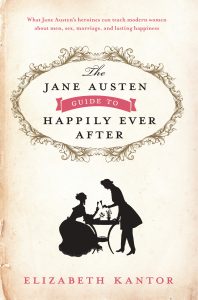The Jane Austen Guide to Happily Ever After
by Elizabeth Kantor
 This book is, by far, the best book I have read on dating with a view towards marriage. I must admit my biases first: I am what is called a “Janeite” and an Anglophile. Although I have never gone to an Austen event or dressed in Regency costume, her novels have been my faithful companions for many years. So this book was basically written for me.
This book is, by far, the best book I have read on dating with a view towards marriage. I must admit my biases first: I am what is called a “Janeite” and an Anglophile. Although I have never gone to an Austen event or dressed in Regency costume, her novels have been my faithful companions for many years. So this book was basically written for me.
Kantor opens the introduction with the question, “Why do women love Jane Austen so much?” As far as I can tell, she is spot-on in her analysis that Austen presents us with people and a world that we would love to be part of. (I would actually expand the question to include men, because when a man picks up a Jane Austen novel with an open mind, he discovers a lot there for him as well. Kantor’s book is addressed almost exclusively to women, and my wish is that she write another for men!) Kantor lays out a compelling case for understanding Jane Austen as “a genius about happy love” (Introduction, page xx).
I must note that the book itself is aesthetically pleasing. It has those lovely rough torn edges to the pages, a nice old-fashioned book jacket, and pull-out sections in the text that add visual variety. The book is also structured in such a way as to induce readers to reflect and, if possible, to discuss the content with others. Every chapter ends with a few questions based on the preceding content, then a sort of “challenge” section entitled, “What Would Jane Do?”, and finally a short advice section called, “If We Really Want to Bring Back Jane Austen…” As a person who tends to breeze through books, I appreciated the encouragement to stop and digest each section before moving on.
In the first chapter, Kantor focuses on happiness in love. All of us want to be “happy”, but we don’t always know what that means, and many people pursue happiness in the wrong way. Austen shows us both kinds of women: heroines who pursue a happy love (think Elizabeth Bennet) and others who fall for a lie and end up marrying jerks (think Lydia Bennet). In this way, Kantor sets the stage for what women should be seeking in their romantic relationships: true happiness.
The next four chapters are elucidations of how to do that: 1.) Don’t fall for a false idea of love, 2.) Don’t be a tragic heroine, 3.) Don’t let cynicism steal your happy ending, and 4.) Do take love seriously. Each chapter focuses on one of Austen’s characters in order to reveal something about dangerous tendencies that women share. The false idea of love that women are particularly susceptible to is that of “sensibility” or sentimentality. (Karol Wojtyla actually discusses this in Love and Responsibility.) The character Laura, in Austen’s teenage work Love and Friendship, is Kantor’s example of this. Laura is always fainting away and declaring that her future happiness depends completely on so-and-so’s affection. The example of a tragic heroine (what not to be) Kantor chooses is Marianne Dashwood. She is not really tragic, Kantor points out, but to her own “romantic sensibilities”, Marianne would have seen herself that way if we’d presented her case to her at the beginning of the novel. Similar to Laura, Marianne saw love as the instant recognition of a soulmate, someone who would evoke extremely strong feelings. Kantor writes, “Jane Austen gives Marianne’s story an ending that’s deliberately unRomantic [sic]”(44). Austen challenges the soulmate narrative. Thirdly, Kantor addresses cynicism, which is a common temptation of single women. Aunt Gardiner, in Pride and Prejudice, warns Elizabeth Bennet about this, and Austen shows that complaining about men is “terribly counter-productive” (55). Austen heroines always treat men with respect. And finally, Kantor uses the anti-heroine Mary Crawford, of Mansfield Park, to illustrate the danger of not taking love seriously. Here, Kantor urges single women to look at their priorities and to judge men according to qualities that are not superficial.
Chapters five through nine are full of great insight and advice for single women that is less directly tied with the “dating scene” and more clearly focused on becoming a virtuous and well-rounded person—a Jane Austen heroine. Here Kantor addresses issues of self-knowledge, friendship, kindness, interdependence, and economic situations. One thing I would add to the friendship section is that observing a man’s friendships is also a great way to learn more about him. The fact that Bingley is a longstanding friend of Darcy, for example, could have clued Elizabeth in to the fact that Darcy is not the horribly proud person she believes him to be.
The rest of Kantor’s book looks at the types of men Jane Austen introduces readers to and how these types are just as valid today as they were then. I found this section surprisingly helpful and illuminating, especially since I am so familiar with the male characters of the novels. It is now almost natural to me to ask myself, upon the prospect of a date with a certain person, whether he seems like a Willoughby or a Darcy. Kantor lays out eight case studies, based on Austen characters, of men who are “afraid of commitment” and what their various obstacles might be. For example, have they already been seeing someone you are not aware of, like Edward Ferrars or Frank Churchill? Are they just looking for a good time regardless of your feelings, like Willoughby or Wickham? Or are they simply a little shy and unsure, like Charles Bingley? Because there are so many possibilities, Kantor counsels single women to maintain thoughtful distance at the beginning of relationships, as we see admiringly modeled by Elinor Dashwood, in order to discern the man’s “intentions” and to be free and uncommitted until such a time as commitment is asked for.
I highly recommend this book to single women, particularly any who enjoy reading Jane Austen or watching the Austen stories on screen. I am not sure that it would be as helpful to people who have not read the novels, since they are referenced constantly. It is a realistic and hopeful guide. This book would be suitable for high school students as well, because it is never too early to become a heroine!
About the reviewer
Sara Perla is the Program Specialist for the Subcommittee for the Promotion and Defense of Marriage at the United States Conference of Catholic Bishops. She attended the Catholic University of America and received her Masters degree in Theological Studies at the Pontifical John Paul II Institute in Washington, D.C. She is also a baker, a ballet dancer, and an avid listener of NPR podcasts.
Disclaimer: Book reviews do not imply and are not to be used as official endorsement by the USCCB of the work or those associated with the work. Book reviews are solely intended as a resource regarding publications that might be of interest to For Your Marriage visitors.




